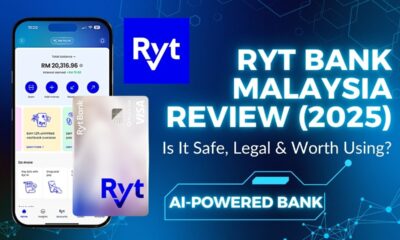FinTech
Are Digital Banks Safe in Malaysia? (2025 Full Security Guide)
Published
17 hours agoon
BNM Licensing • PIDM Protection • Cybersecurity • Fraud Prevention
Digital banks are now one of Malaysia’s fastest-growing financial trends, but many Malaysians still ask the same question:
“Is digital banking really safe?”
Short answer:
Yes — Malaysia’s digital banks are extremely safe, because they follow the same regulatory, cybersecurity, and deposit-protection standards as traditional banks.
1. Digital Banks Are Fully Licensed by Bank Negara Malaysia (BNM)
All digital banks in Malaysia operate under the BNM Digital Banking Framework, which includes strict requirements in:
- capital adequacy
- cybersecurity controls
- fraud monitoring
- data protection
- operational risk
- consumer rights & transparency
- AML/CFT compliance
This means digital banks follow the same regulations as traditional banks.
Licensed Digital Banks in Malaysia
- RYT Bank (YTL × Sea Group)
- GXBank (Grab × Singtel)
- Boost Bank (Axiata × RHB)
- AEON Bank
- KAF Bank (Islamic)
2. PIDM Protection: Up to RM250,000 Coverage Per Depositor
All Malaysian digital banks offer PIDM protection once a customer’s funds are placed with the bank’s PIDM-insured deposit structure. PIDM covers up to RM250,000 per depositor.
PIDM Covers:
- savings accounts
- pockets / jars
- term/fixed deposits (if offered)
| Digital Bank | PIDM Protection |
|---|---|
| RYT Bank | Yes (RM250k) |
| GXBank | Yes |
| Boost Bank | Yes (via RHB) |
| AEON Bank | Yes |
| KAF Bank | Yes |
For a deeper look into how individual banks manage safety and deposit protection, see our reviews of RYT Bank safety details and
GXBank Malaysia review.
3. Cybersecurity Standards Required by BNM
Digital banks must comply with RMiT (Risk Management in Technology), one of the strongest cybersecurity standards in Southeast Asia.
Security Requirements Include:
- Biometric login, 2FA, device binding
- Real-time AI fraud detection
- End-to-end encryption
- ISO/IEC 27001 cloud infrastructure
4. Digital Banks vs Traditional Banks — Which Is Safer?
| Category | Digital Banks | Traditional Banks |
|---|---|---|
| BNM regulation | ✔ Yes | ✔ Yes |
| PIDM protection | ✔ Yes | ✔ Yes |
| Fraud detection | AI-driven | Moderate |
| System infrastructure | Modern cloud | Older systems |
| Branches | ❌ No | ✔ Yes |
| Onboarding | eKYC online | Physical or online |
Result: Digital banks have stronger security because they run on modern infrastructure and AI monitoring.
5. Why Digital Banks Can Be More Secure
1) No legacy systems
Built with modern encryption, real-time systems, and cloud security.
2) AI fraud monitoring
Transactions are analysed instantly to detect suspicious behaviour.
3) Lower human error
Automated processes (eKYC, credit scoring, fraud detection) reduce mistakes.
6. Risks Malaysians Should Still Consider
- No branches — all support is online.
- New track record — digital banks only launched recently.
- Promotional rates may change — high interest may be time-limited.
7. Digital Banks vs E-Wallets (Safety Comparison)
| Feature | Digital Banks | E-Wallets |
|---|---|---|
| BNM banking license | ✔ Yes | ❌ No |
| PIDM protection | ✔ Yes | ❌ No |
| Fraud monitoring | AI-level | Moderate |
| Savings interest | ✔ Yes | Limited |
Winner: Digital banks are significantly safer than e-wallets.
Final Verdict — Are Digital Banks Safe?
Yes. All digital banks in Malaysia are extremely safe.
- ✔ Fully licensed by BNM
- ✔ PIDM protection up to RM250k
- ✔ AI-based fraud detection
- ✔ Encrypted transactions
- ✔ Modern, cloud-native security
Digital banks offer the same protection as traditional banks — and often, stronger security.
FAQs — Digital Bank Safety in Malaysia (2025)
1. Are digital banks safe in Malaysia?
Yes. All digital banks in Malaysia are licensed and regulated by Bank Negara Malaysia (BNM). Deposits are protected by PIDM up to RM250,000 per depositor. They also use advanced cybersecurity measures such as AI fraud detection, 2FA, device binding, and encryption.
2. Are digital banks licensed by Bank Negara Malaysia?
Yes. All five digital banks — RYT Bank, GXBank, Boost Bank, AEON Bank, and KAF Bank — operate under the BNM Digital Banking Framework, which enforces strict rules on cybersecurity, risk management, capital adequacy, and consumer protection.
3. Are digital bank deposits protected by PIDM?
Yes. Digital bank deposits are protected by PIDM up to RM250,000 per depositor, similar to traditional banks. PIDM covers savings accounts, pockets, and eligible term-deposit products.
4. Which digital bank is the safest in Malaysia?
All licensed digital banks meet the same BNM and PIDM safety requirements. However, banks like RYT Bank and GXBank use advanced AI-based fraud monitoring and cloud-native infrastructure, making them among the most secure in practice.
5. Are digital banks safer than e-wallets?
Yes. Digital banks follow stricter regulations and cybersecurity standards than e-wallets. They offer PIDM protection, stronger fraud detection, and more stringent authentication requirements.

How Technology Is Transforming the Art Scene in Malaysia

How Smart Platforms Complement CRM Software to Drive Business Agility

Are Digital Banks Safe in Malaysia? (2025 Full Security Guide)

Can Your PC Run GOTY 2023 & 2024 Winners

Ranking The Best Digital Agency in Malaysia

Boost Your Online Visibility with Professional SEO Services in Malaysia

Rapid Recovery: The Essential Steps of Professional Fire Cleanup

How a Step-Up SIP Changes the Entire Returns Game!

Stablecoin Settlement vs Card Rails for Gaming Payouts








